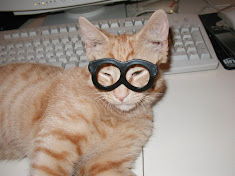 |
| American Curl Catching a Ride by Katja Maasing |
When Curls are born, their ears are straight. In 3 to 5 days they start to curl back staying in a tight rosebud position, unfurling gradually until permanently 'set' at around 16 weeks. This is the time breeders determine the kitten's ear quality as either pet or show in addition to the kitten's overall conformation. The degree of ear curl can vary greatly, ranging from almost straight (pet quality) to a show quality ear with an arc of 90-180 degrees resembling a graceful shell-like curvature. Although the distinctive feature of the American Curl is their uniquely curled ears, the medium-sized rectangular body, silky flat-lying coat, and expressive walnut-shaped eyes are equally indicative of the breed. They are available in both long and shorthair color and pattern varieties, and since there is minimal undercoat, the Curl sheds little and requires hardly any grooming.
Indeed, the discovery of a novel cat is an event of great importance to feline fans and fanatics, and especially true when it is inherently born to radiate well-being and good things to all fortunate enough to hold one. As the founder of this amazingly spiritual breed says, "They are not just 'decorator' cats. You might say that they are 'designer' cats, perhaps even signed masterpieces of a humor-loving Creator."
Pricing on American Curls usually depends on type, applicable markings and bloodlines distinguished by Grand Champion (GC), National, National Breed and/or Regional winning parentage (NW, BW, RW) or of Distinguished Merit parentage (DM). The DM title is achieved by the dam (mother) having produced five CFA grand champion/premier (alter) or DM offspring, or sire (father) having produced fifteen CFA grand champion/premier offspring. Usually breeders make kittens available between twelve and sixteen weeks of age. After 12 weeks, kittens have had their basic inoculations, and developed the physical and social stability needed for a new environment, showing, or being transported by air. Keeping such a rare treasure indoors, neutering or spaying, and providing acceptable surfaces (e.g. scratching posts) for the natural behavior of scratching (CFA disapproves of declawing or tendonectomy surgery) are essential elements for maintaining a healthy, long and joyful life.
About the Author
Animal44 is the owner and administrator of http://thatdarncat.aimoo.com a discussion board that spans all aspects of cats. You may repost this article as long as all links and original content are included.



0 comments:
Post a Comment